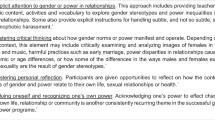Abstract
Best practices for adolescent sex education recommend science-based approaches. However, little is known about the capacity and needs of organizations who implement sex education programs on the local level. The purpose of this research was to describe successes and challenges of community organizations in implementing science-based sex education. Using qualitative methods, we interviewed program directors and educators in 17 state-funded adolescent pregnancy prevention/sex education programs as part of a larger mixed methods evaluation. Semi-structured interviews focused on success and challenges faced in implementing science-based approaches to program design, implementation and evaluation. Interviews were audio-recorded, transcribed and analyzed using a thematic approach. Grantees included a range of programs, from short programs on puberty and HIV for late elementary students, to skills-based curricular sex education programs for high schools, to year-long youth development programs. Key aspects of curricular choice included meeting the needs of the population, and working within time constraints of schools and other community partners. Populations presenting specific challenges included rural youth, youth in juvenile justice facilities, and working with Indiana’s growing Latino population. Programs self-developing curricula described challenges related to assessment and evaluation of impact. Programs using commercial curricula described challenges related to curricular selection and adaptation, in particularly shortening curricula, and adapting to different cultural or social groups. A remarkable degree of innovation was observed. The use of qualitative methods permitted the identification of key challenges and successes in a state-sponsored small grants program. Information can be used to enhance program capacity and quality.

Similar content being viewed by others
References
Indiana State Department of Health. Indiana Respect. (2007). [cited May 8, 2009]; Available from: http://www.indianarespect.com/whatIs.asp.
Santelli, J. S. (2008). Medical accuracy in sexuality education: Ideology and the scientific process. American Journal of Public Health, 98, 1786–1792.
Centers for Disease Control and Prevention. (2007). Definitions of science-based approach, science-based program, and promising program. Adolescent Reproductive Health: Promoting Science Based Approaches. [cited 2009 May 8]; Available from: http://www.cdc.gov/reproductivehealth/AdolescentReproHealth/DefineScienceApproach.htm.
Kirby, D. (2007). Emerging answers 2007: Research findings on programs to reduce teen pregnancy and sexually transmitted diseases. Washington, DC: National Campaign to Prevent Teen and Unplanned Pregnancy.
Kirby, D., Rolleri, L., & Wilson, M. (2007). Tool to assess the characteristics of effective sex and Std/HIV education programs. Washington, DC: Healthy Teen Network.
Albert, B. (2007). With one voice 2007: America’s adults and teens sound off about teen pregnancy. Washington, DC: National Campaign to Prevent Teen Pregnancy.
Healthy Teen Network. Science Based Approaches: Adaptation. (2008). [cited 2008 November 25]; Available from: http://www.healthyteennetwork.org/index.asp?Type=B_BASIC&SEC={E8F6E426-A1D8-4DBC-8CCF-1C68EB3BFEDB}&DE={1EE1BD19-5BEF-468D-918B-F36FA6134243}.
Braun, V., & Clarke, V. (2006). Using thematic analysis in psychology. Qualitative Research in Psychology, 3, 77–101.
Houston, S. (2001). Beyond social constructionism: Critical realism and social work. British Journal of Social Work, 31, 845–861.
Healthy Teen Network. Science-Based Programs. (2008). [cited 2008 August 22]; Available from: http://www.healthyteennetwork.org/index.asp?Type=B_BASIC&SEC={E8F6E426-A1D8-4DBC-8CCF-1C68EB3BFEDB}&DE={C0E02180-C80D-422B-B7C0-4FAE9B098193}.
Advocates for Youth. (2003). Science and success: Sex education and other programs that work to prevent teen pregnancy, HIV and sexually transmitted diseases. Washington, DC: Advocates for Youth.
National Campaign to Prevent Teen Pregnancy. What works: Curriculum-based programs that prevent teen pregnancy. In: Putting what works to work. Washington, DC: National Campaign to Prevent Teen Pregnancy.
Centers for Disease Control and Prevention. (2008). Adolescent reproductive health: Promoting science-based approaches to prevent teen pregnancy, HIV, and Stds: Definitions of science-based approach, science-based program, and promising program. 2008 October 5, 2007 [cited 2008 September 11]; Available from: http://www.cdc.gov/reproductivehealth/AdolescentReproHealth/DefineScienceApproach.htm.
Criminal Neglect: Substance Abuse, Juvenile Justice and the Children Left Behind. New York: The National Center on Addiction and Substance Abuse at Columbia University, 2004.
Romero, E. G., Teplin, L. A., McClelland, G. M., et al. (2007). A longitudinal study of the prevalence, development, and persistence of HIV/sexually transmitted infection risk behaviors in delinquent youth: Implications for health care in the community. Pediatrics, 119, e1126–1141.
Vermeiren, R., Jespers, I., & Moffitt, T. (2006). Mental health problems in juvenile justice populations. Child and Adolescent Psychiatric Clinics of North America, 15, 333–351.
Rural Center for AIDS/STD Prevention. (2002). Aids and sexually transmitted diseases in the rural south, Fact Sheet #14. Bloomington, IN: Indiana University, Purdue University and Texas A&M University.
Stanton, B., Harris, C., Cottrell, L., et al. (2006). Trial of an urban adolescent sexual risk-reduction intervention for rural youth: A promising but imperfect fit. Journal of Adolescent Health, 38, 55. e25–55. e36.
Smith, M. U., & DiClemente, R. J. (2000). Stand: A peer educator training curriculum for sexual risk reduction in the rural south. Preventive Medicine, 30, 441–449.
Stanton, B., Guo, J., Cottrell, L., et al. (2005). The complex business of adapting effective interventions to new populations: An urban to rural transfer. Journal of Adolescent Health, 37, 163.
Rogers, E. M. (1995). Diffusion of innovations (4th ed.). New York: Free Press.
Acknowledgments
This research was supported in part by NIH (K23-HD049444-01A2) . These data were originally presented as a poster at the Pediatric Academic Societies and Asian Society for Pediatric Research Joint Meeting, Honolulu, May 2008. The authors thank the Indiana State Department of Health for their support of program evaluation. The information in this paper does not necessarily represent the views of the Indiana State Department of Health.
Author information
Authors and Affiliations
Corresponding author
Appendix A
Rights and permissions
About this article
Cite this article
Ott, M.A., Rouse, M., Resseguie, J. et al. Community-Level Successes and Challenges to Implementing Adolescent Sex Education Programs. Matern Child Health J 15, 169–177 (2011). https://doi.org/10.1007/s10995-010-0574-y
Published:
Issue Date:
DOI: https://doi.org/10.1007/s10995-010-0574-y



